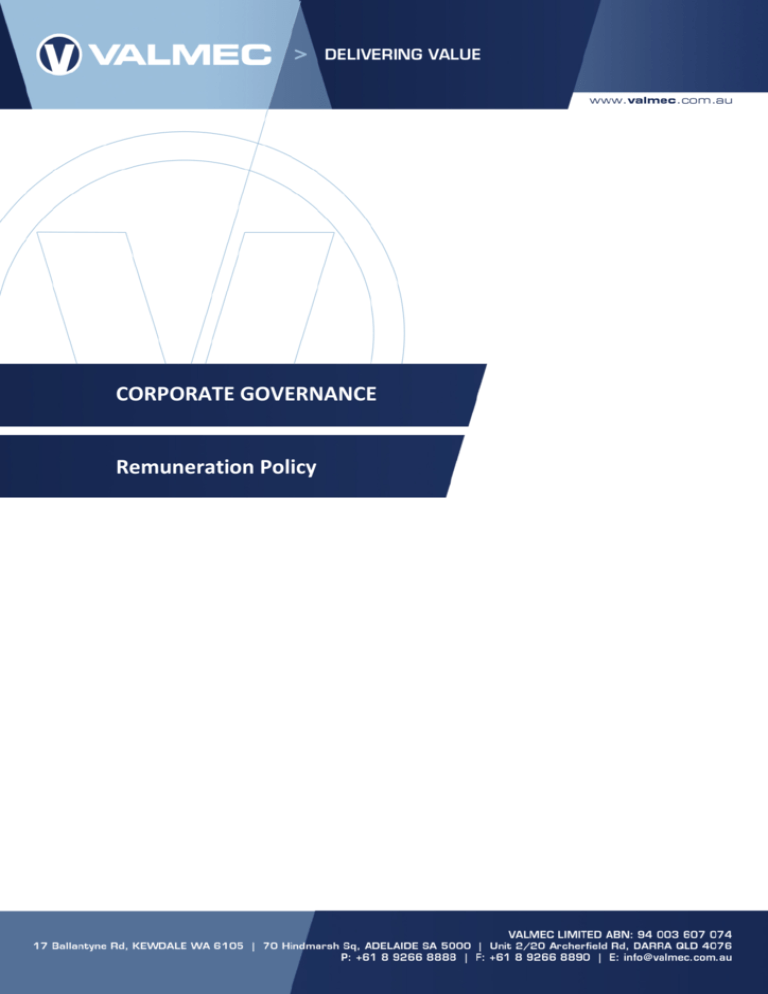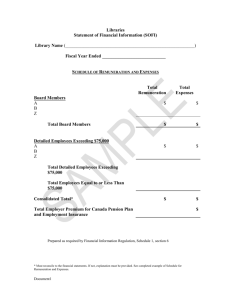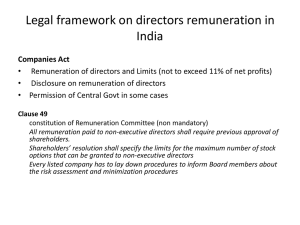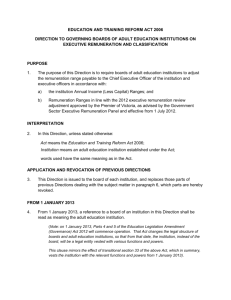Remuneration Policy
advertisement

CORPORATE GOVERNANCE Remuneration Policy REMUNERATION POLICY TABLE OF CONTENTS 1. PURPOSE OF POLICY ............................................................................................................ 3 2. EXECUTIVE DIRECTORS/SENIOR MANAGEMENT ................................................................... 3 2.1. Framework.............................................................................................................................. 3 2.2. Components of Remuneration ............................................................................................... 3 2.3. Fixed Remuneration ............................................................................................................... 4 3. NON - EXECUTIVE DIRECTORS .............................................................................................. 4 4. APPROVAL .......................................................................................................................... 5 Remuneration Policy Corporate Governance 2 of 5 REMUNERATION POLICY 1. PURPOSE OF POLICY The remuneration policy of Valmec Limited has been designed to align director and executive objectives with shareholder and business objectives by providing a fixed remuneration component and offering specific long-term incentives based on key performance areas affecting the consolidated entity’s financial results. The board of Valmec Limited believes the remuneration policy to be appropriate and effective in its ability to attract and retain the best executives and directors to run and manage the consolidated entity, as well as create goal congruence between directors, executives and shareholders The board’s policy for determining the nature and amount of remuneration for board members and senior executives of the consolidated entity is as follows. 2. EXECUTIVE DIRECTORS/SENIOR MANAGEMENT 2.1. Framework The primary objective of the Valmec management remuneration strategy is creating a framework that supports sustainable and resilient growth over the long term, recognising that this is in the interest of all stakeholders. This framework seeks to reward, retain, and motivate senior executives in a manner aligned with shareholders interests. 2.2. Components of Remuneration Remuneration and other terms of employment for the Management Team are formalised in Employee Agreements, Executive Service Agreements and incentive plans. The Remuneration and Nominations Committee reviews executive packages annually by reference to the consolidated entity’s performance, executive performance and comparable information from industry sectors and other listed companies in similar industries. Valmec sets the fixed remuneration based on the assessment of market data of external consultants and the Company’s size, internal metrics and data. Salary reviews will be conducted annually commencing in May of each year and subject to final Remuneration and Nominations Committee approval, will be effective July 1 thereafter. The performance of executives is measured against criteria agreed annually with each executive and is based predominantly on the forecast growth of the consolidated entity’s profits and shareholders’ value. All bonuses and incentives are linked to predetermined performance criteria. The board may, however, exercise its discretion in relation to approving incentives and bonuses and can recommend changes to the committee’s recommendations. Any changes must be justified by reference to measurable performance criteria. The policy is designed to attract the highest calibre of executives and reward them for performance that results in long-term growth in shareholder wealth. Participants in the company’s equity based remuneration schemes are not permitted to enter into transactions which limit the economic risk of participating in the scheme. The total remuneration packages for these Management may include a combination of the following: Fixed component – Base salary including superannuation. This is expressed as a specific amount that the executive may take in a form agreed with the Company and is determined based on market reference, the scope and nature of the individual’s role, their performance and experience. Remuneration Policy Corporate Governance 3 of 5 REMUNERATION POLICY 2.3. At risk components – The Board considers that the financial and operational performance and prospects of the Company are strongly linked to creating shareholder wealth. Accordingly, the Board has put in place at-risk components to remuneration based on success in delivering on pre-defined targets. At-risk components are in the form of: o Short Term Incentive (STI) – payable in cash. Outcomes are based on Valmec’s financial and operational performance over the financial period, in addition to individual performance measures; o Long Term Incentives (LTI) – includes the issue of Performance Rights and Share Options that are subject to the satisfaction of performance hurdles. These LTI instruments are issued to Management for the purposes of aligning their interests with those of shareholders by rewarding long term sustainable shareholder value creation. For the FY15 LTI plan, outcomes are based on Relative Total Shareholder Return TSR measures. Fixed Remuneration The fixed remuneration component of staff salaries includes a base salary and superannuation. Fixed remuneration may be allocated at the recipient’s discretion to cash, superannuation (subject to legislative minimum) and motor vehicles. The fixed remuneration component is determined based on the scope and nature of the individual’s role, their performance and experience. The employment contracts typically stipulate 1 month resignation periods other than the Managing Director. The Company may terminate the Managing Director’s employment contract without cause by providing 3 months written notice, and at the end of that notice period, make a payment equal to the salary payable over a 3 month period. The Company may also at its sole discretion terminate an employment contract immediately by making a payment equal to the salary for the relevant period of notice. 3. NON - EXECUTIVE DIRECTORS The board policy is to remunerate non-executive directors at market rates for comparable companies for time, commitment and responsibilities. The remuneration and nominations committee determines payments to the non-executive directors and reviews their remuneration annually, based on market practice, duties and accountability. Independent external advice is sought when required. The maximum aggregate amount of fees that can be paid to non-executive directors is subject to approval by shareholders at the Annual General Meeting and is presently set at an aggregate of $300,000 per annum. Fees for non-executive directors are not linked to the performance of the consolidated entity and they are not able to participate in equity schemes of the company or receive performance based bonuses. However, to align directors’ interests with shareholder interests, the directors are encouraged to hold shares in the Company. There are no employment contracts relating to Non-Executive Directors or the Company Secretary other than those outlined above. Remuneration Policy Corporate Governance 4 of 5 REMUNERATION POLICY 4. APPROVAL This policy was approved by resolution of the Valmec Limited Board: _____________________________ Steve Dropulich, Managing Director Date: 21 July 2015 Remuneration Policy Corporate Governance 5 of 5






